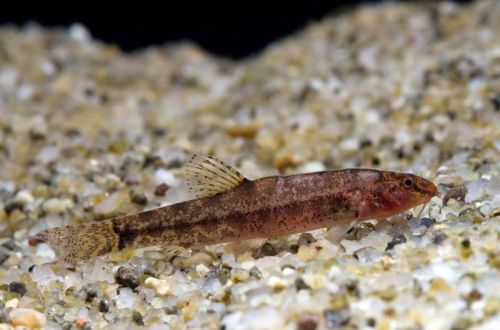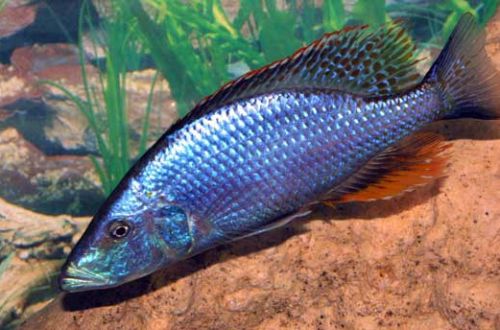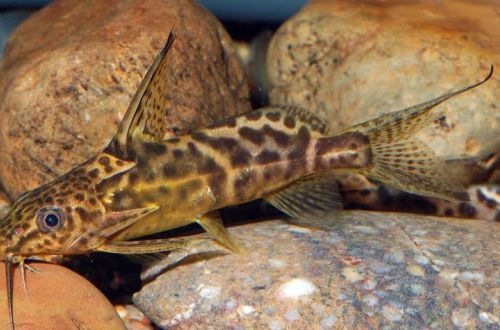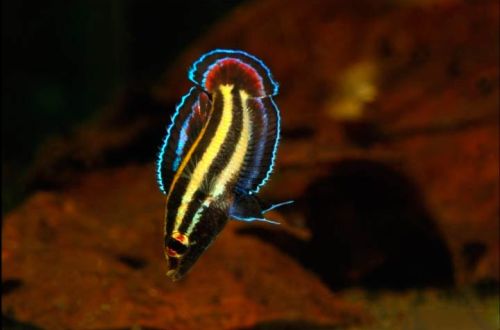
Forktail goblet
Forktail charr, scientific name Lepidocephalichthys furcatus, belongs to the Cobitidae (Loach) family. Although this fish is not distinguished by bright colors, it has other advantages – endurance and unpretentiousness. Will be a great addition to the community of other freshwater peaceful species. May be recommended for beginner aquarists.

Contents
Habitat
The fish comes from Southeast Asia from the Indochina and Malacca peninsulas, as well as the island of Sumatra. Inhabits shallow water bodies with stagnant water or slow flow, such as backwaters of rivers, lakes, swamps, and is not uncommon in rice fields.
Natural habitats are characterized by a large amount of plant debris on the bottom (leaves, branches, roots) interspersed with a layer of silt.
Brief information:
- The volume of the aquarium – from 40 liters.
- Temperature – 23-26°C
- Value pH — 5.5–7.5
- Water hardness – soft (1-10 dGH)
- Substrate type – soft sandy
- Lighting – subdued
- Brackish water – no
- Water movement is weak
- The size of the fish is 4–5 cm.
- Nutrition – protein-rich food, sinking
- Temperament – peaceful
- Content in a group of 4 individuals
Description
Adult individuals reach a length of 4–5 cm. The body is elongated, the fins are short. The color is gray with brown pigmentation. The extreme rays of the caudal fin are elongated, creating the feeling of a forked tail. A similar feature is reflected in the name of this species – “forktail”, and is no longer found in other members of the genus.
Sexual dimorphism is weak, males and females have few visible differences, but the latter may look more massive than males.
Food
In nature, they feed by sifting portions of the soil in search of small invertebrates. In a home aquarium, the basis of the diet should be sinking foods rich in protein, as well as fresh, frozen brine shrimp, bloodworms, daphnia and other products.
Maintenance and care, arrangement of the aquarium
The optimal size of the aquarium for a group of 4 fish starts from 40 liters. Given the characteristics of nutrition, the main emphasis in the design should be given to the substrate. It is necessary to use fine-grained sandy soil so that the fish can sift it with their mouths during feeding. For the same reason, it is worth carefully choosing rooted plants. Species with weak root systems are likely to be uprooted quickly. Driftwood and other natural or artificial decoration elements are placed at the bottom, which can act as a shelter. Will complement the design of the leaves of some trees, such as Indian almond, oak, birch, alder and others. In addition, the leaves will give the water a chemical composition characteristic of the habitats of the Forktail Char. For more information, see the section “Which tree leaves can be used in an aquarium”.
For long-term maintenance, it is important to provide soft, slightly acidic water, weekly maintenance of the aquarium to prevent the accumulation of organic waste (food residues, excrement), and preventive maintenance of equipment.
Behavior and Compatibility
Peacefully tuned in relation to relatives and other types of fish. They prefer to be in groups, so it is advisable to purchase from 4-5 individuals. As neighbors, fish that live in the middle and upper layer of water are suitable – these are most cyprinids, such as zebrafish, rasboras and others.
Reproduction / breeding
The appearance of offspring in the Forktail Loaches in nature is seasonal. Spawning is stimulated by changes in the environment. At the time of writing, no successful cases of breeding in the home aquarium have been recorded.
Fish diseases
Finding the fish in a suitable habitat, getting them a balanced diet and free from external threats such as attacks from tankmates is the best guarantee against disease. The appearance of signs of illness can be a signal that there are problems in the content. Usually, bringing the habitat back to normal contributes to self-healing, but if the body of the fish has suffered too much, then medical treatment will be required. Read more about symptoms and treatments in the Aquarium Fish Diseases section.





